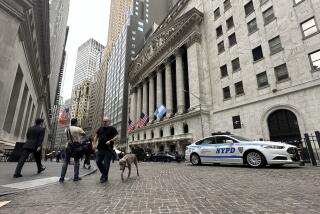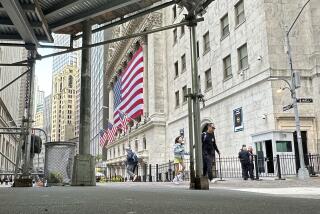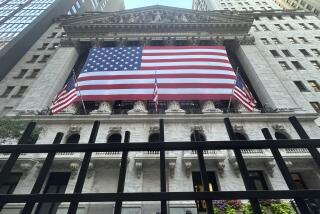FINANCIAL MARKETS : Dow Up 17.26; Stocks Pull Out of 3-Day Skid
NEW YORK — The stock market rebounded from a three-session slide Thursday, encouraged by lower interest rates.
The Dow Jones index of 30 industrials, down 21.47 points in the week’s first three sessions, recovered 17.26 to 2,482.17.
Advancing issues outnumbered declines by nearly 4 to 3 in nationwide trading of New York Stock Exchange-listed stocks.
Volume on the floor of the Big Board came to 176.51 million shares, up from 168.83 million in the previous session.
Analysts said traders were encouraged to see interest rates decline slightly in the government securities market despite a mixed dollar in foreign exchange.
But many Wall Streeters were still treading cautiously as they awaited indications of the Federal Reserve’s next move in its credit policy.
The Commerce Department revised its figure for growth of the gross national product in the first quarter to an annual rate of 4.4%, after adjustment for inflation. Previously the department had estimated it at 4.3%.
Analysts said such a small adjustment didn’t do much to stir the market out of its recent lethargy.
On the market agenda for today are monthly reports on new orders for durable goods and personal income and spending for May.
Newmont Mining climbed 5 1/4 to 40 1/8 and Hanson PLC gained 7/8 to 16 7/8. Hanson made a bid to take over Consolidated Gold Fields, which owns 49% of Newmont.
First Interstate closed down 5/8 at 64 5/8.
Gainers among the blue chips included McDonald’s, up 1 1/8 at 29 3/8; General Electric, up 3/8 at 53 5/8; Philip Morris, up 1 3/4 at 138, and Eastman Kodak, up 1 at 48 3/8.
Integrated Resources common shares rose 5/8 to 4 5/8 and three of the company’s preferred stocks ranked as the day’s best percentage gainers among NYSE issues.
Financier Robert M. Bass was reported to have talked with the troubled real estate and insurance concern about investing in it in exchange for a controlling interest.
Stride Rite gained 7/8 to 54 3/8, hitting a new 52-week high. Buying in the stock was ascribed both to takeover speculation and expectations of a strong quarterly earnings showing by the company.
Mack Trucks dropped 1/2 to 12 1/8 in the over-the-counter market. The company said it expects to post a loss for the second quarter and the first half of the year.
The Wilshire index of 5,000 equities closed at 3,179.900, up 14.402.
The NYSE’s composite index of all its listed common stocks picked up 0.87 to 180.05.
Standard & Poor’s industrial index rose 1.87 to 368.43, and S&P;’s 500-stock composite index was up 1.84 at 322.32.
The NASDAQ composite index for the over-the-counter market added 1.47 to 445.33. At the American Stock Exchange, the market-value index closed at 362.21, up 1.14.
In Tokyo, the 225-share Nikkei index lost 20.31 points to close at 33,324.97.
Share prices on London’s Stock Exchange closed higher as Hanson PLC’s surprise $4.8-billion bid for Consolidated Gold Fields prompted strong gains in the mining and aggregate sectors of the market. The Financial Times 100-share index closed at 2,180.0, up 7.8 points.
Credit
The latest government report on economic growth tipped bond prices higher in quiet trading.
The Treasury’s closely watched 30-year bond gained 1/4 point, or $2.50 for every $1,000 in face value. Its yield, which moves in the opposite direction from price, slipped to 8.32% from 8.34% late Wednesday.
Analysts said bond prices were lifted by the revise of the GNP.
Though the growth rate was slightly higher than previously believed, much of it was due to a rebound from last summer’s drought, a one-time boost that reflected the government’s accounting methods and masked otherwise slow growth. Bond prices react positively to such news because it implies lower inflation.
“It was a slight positive, but overall the report was fairly neutral for the market,” said Elizabeth Reiners, a vice president of Dean Witter Reynolds Inc.
Bond prices lost some ground in afternoon trading as the dollar weakened, analysts said.
“The market really didn’t do a whole lot,” said Elliott Platt, research director at DL&J; Securities Inc.
In the secondary market for Treasury bonds, prices of short-term government issues edged up 1/16 point, intermediate maturities rose 1/8 point to 5/32 point, and 20-year issues gained 1/8 point, according to Telerate Inc., a financial information service.
The movement of a point is equivalent to a change of $10 in the price of a bond with a $1,000 face value.
The federal funds rate, the interest on overnight loans between banks, was quoted late in the day at 9.625%, up from 9.375% late Wednesday.
Currency
The dollar sank against major foreign currencies in a slide deepened by a rumor, quickly denied by the White House, that President Bush had been shot.
The dollar managed to recover some lost ground after the White House denial. Currency dealers said the rumor circulated in foreign exchange markets for 45 minutes to an hour.
But a lack of buying interest in the dollar plus dollar sales by central banks to prop up the sagging British pound contributed to a generally weak day for the dollar, dealers said.
William Mikus, a vice president at Salomon Bros., said the Bush rumor “probably pushed the dollar through 140 yen, triggering a lot of stop-loss sales,” which were aimed at limiting losses by unloading dollars in case the currency declined further.
Bob Morrissey, a senior trader at Bank of Boston’s New York office, said trading was thin and choppy with the market on guard for possible central bank intervention.
A report by a Washington-based consulting group that Japan, the United States and West Germany were determined to bring the dollar lower by selling the American currency has been denied by central banks but has left traders extra wary, Morrissey said.
Gold prices pulled back slightly in the United States after rising on markets abroad. Republic National Bank of New York quoted a bid of $370.25 for an ounce of gold at 4 p.m. EDT, down $1 from Wednesday’s late bid.
Commodities
Reports of sugar purchases by the Soviet Union whipped the sugar futures market into a bullish frenzy, with prices reaching an 11-month high on speculation that the surprise transactions implied further buying down the road.
On other markets, corn and soybean futures wilted as rain arrived in Iowa; coffee futures rallied, and energy, precious metals and livestock and meat futures were mixed.
Sugar futures settled 0.50 cent to 0.94 cent higher on New York’s Coffee, Sugar & Cocoa Exchange, with the contract for delivery in July at $1.399 a pound, the market’s highest level since July 25.
The rally was fueled by trade reports that the Soviets had bought two cargoes of refined white sugar and one cargo of raw sugar on the open market. One cargo equals 10,000 to 12,000 metric tons.
The Soviet Union usually does its sugar buying in the fall and winter and had stated repeatedly earlier this year that it had completed its sugar buying for all of 1989.
“A lot of people in the business view this as the tip of the proverbial iceberg, meaning the Soviets will come in and do even more shopping,” said Arthur Stevenson, an analyst who follows the sugar, coffee and cocoa markets for Prudential-Bache Securities Inc.
Analysts predicted that new Soviet purchases would total at least 100,000 metric tons and could run as high as 300,000 metric tons.
Corn and soybean futures fell sharply on the Chicago Board of Trade as showers drenched some of the driest croplands in Iowa.
Rainfall amounts varied widely in the western Corn Belt, but one report of a four-inch dousing in western Iowa apparently convinced traders that the severely dry conditions there were finally easing.
Unleaded gasoline futures climbed sharply on the New York Mercantile Exchange following an Energy Department report that refuted Tuesday’s American Petroleum Institute report showing a substantial rise in U.S. stocks of gasoline. The rally spilled over to the crude oil and heating oil markets.
West Texas Intermediate crude oil settled 1 cent lower to 10 cents higher, with August at $19.30 a barrel; heating oil was 0.64 cent to 1.02 cents higher, with July at 48.62 cents a gallon, and unleaded gasoline was 0.56 cent to 1.89 cents higher, with July at 60.99 cents a gallon.
More to Read
Inside the business of entertainment
The Wide Shot brings you news, analysis and insights on everything from streaming wars to production — and what it all means for the future.
You may occasionally receive promotional content from the Los Angeles Times.










